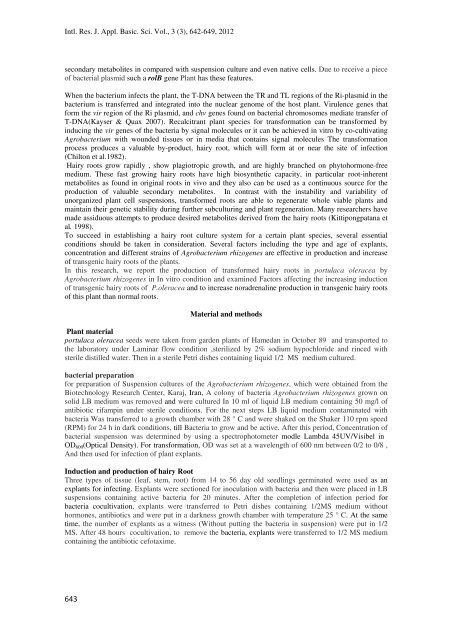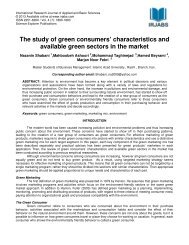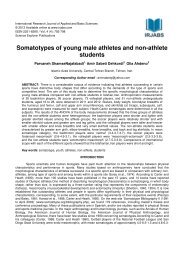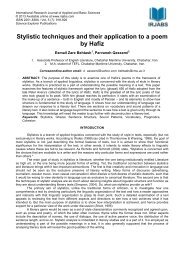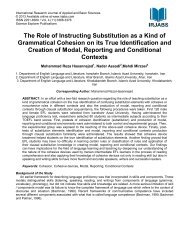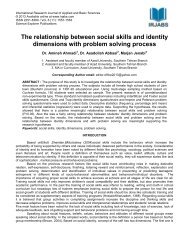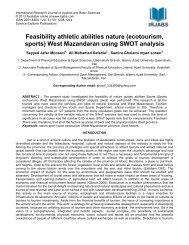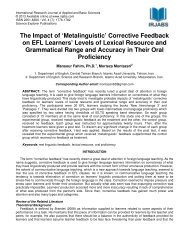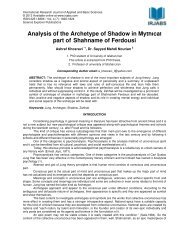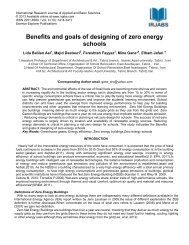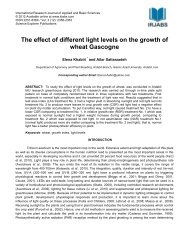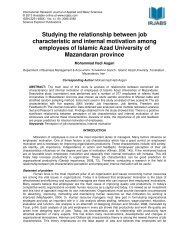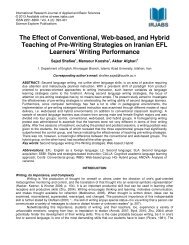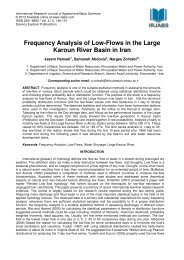Hairy roots induction from Portulaca oleracea using ... - irjabs.com
Hairy roots induction from Portulaca oleracea using ... - irjabs.com
Hairy roots induction from Portulaca oleracea using ... - irjabs.com
You also want an ePaper? Increase the reach of your titles
YUMPU automatically turns print PDFs into web optimized ePapers that Google loves.
Intl. Res. J. Appl. Basic. Sci. Vol., 3 (3), 642-649, 2012secondary metabolites in <strong>com</strong>pared with suspension culture and even native cells. Due to receive a pieceof bacterial plasmid such a rolB gene Plant has these features.When the bacterium infects the plant, the T-DNA between the TR and TL regions of the Ri-plasmid in thebacterium is transferred and integrated into the nuclear genome of the host plant. Virulence genes thatform the vir region of the Ri plasmid, and chv genes found on bacterial chromosomes mediate transfer ofT-DNA(Kayser & Quax 2007). Recalcitrant plant species for transformation can be transformed byinducing the vir genes of the bacteria by signal molecules or it can be achieved in vitro by co-cultivatingAgrobacterium with wounded tissues or in media that contains signal molecules The transformationprocess produces a valuable by-product, hairy root, which will form at or near the site of infection(Chilton et al.1982).<strong>Hairy</strong> <strong>roots</strong> grow rapidly , show plagiotropic growth, and are highly branched on phytohormone-freemedium. These fast growing hairy <strong>roots</strong> have high biosynthetic capacity, in particular root-inherentmetabolites as found in original <strong>roots</strong> in vivo and they also can be used as a continuous source for theproduction of valuable secondary metabolites. In contrast with the instability and variability ofunorganized plant cell suspensions, transformed <strong>roots</strong> are able to regenerate whole viable plants andmaintain their genetic stability during further subculturing and plant regeneration. Many researchers havemade assiduous attempts to produce desired metabolites derived <strong>from</strong> the hairy <strong>roots</strong> (Kittipongpatana etal. 1998).To succeed in establishing a hairy root culture system for a certain plant species, several essentialconditions should be taken in consideration. Several factors including the type and age of explants,concentration and different strains of Agrobacterium rhizogenes are effective in production and increaseof transgenic hairy <strong>roots</strong> of the plants.In this research, we report the production of transformed hairy <strong>roots</strong> in portulaca <strong>oleracea</strong> byAgrobacterium rhizogenes in In vitro condition and examined Factors affecting the increasing <strong>induction</strong>of transgenic hairy <strong>roots</strong> of P.<strong>oleracea</strong> and to increase noradrenaline production in transgenic hairy <strong>roots</strong>of this plant than normal <strong>roots</strong>.Material and methodsPlant materialportulaca <strong>oleracea</strong> seeds were taken <strong>from</strong> garden plants of Hamedan in October 89 and transported tothe laboratory under Laminar flow condition ,sterilized by 2% sodium hypochloride and rinced withsterile distilled water. Then in a sterile Petri dishes containing liquid 1/2 MS medium cultured.bacterial preparationfor preparation of Suspension cultures of the Agrobacterium rhizogenes, which were obtained <strong>from</strong> theBiotechnology Research Center, Karaj, Iran, A colony of bacteria Agrobacterium rhizogenes grown onsolid LB medium was removed and were cultured In 10 ml of liquid LB medium containing 50 mg/l ofantibiotic rifampin under sterile conditions. For the next steps LB liquid medium contaminated withbacteria Was transferred to a growth chamber with 28 ° C and were shaked on the Shaker 110 rpm speed(RPM) for 24 h in dark conditions, till Bacteria to grow and be active. After this period, Concentration ofbacterial suspension was determined by <strong>using</strong> a spectrophotometer modle Lambda 45UV/Visibel inOD 600 (Optical Density). For transformation, OD was set at a wavelength of 600 nm between 0/2 to 0/8 ,And then used for infection of plant explants.Induction and production of hairy RootThree types of tissue (leaf, stem, root) <strong>from</strong> 14 to 56 day old seedlings germinated were used as anexplants for infecting. Explants were sectioned for inoculation with bacteria and then were placed in LBsuspensions containing active bacteria for 20 minutes. After the <strong>com</strong>pletion of infection period forbacteria cocultivation, explants were transferred to Petri dishes containing 1/2MS medium withouthormones, antibiotics and were put in a darkness growth chamber with temperature 25 ° C. At the sametime, the number of explants as a witness (Without putting the bacteria in suspension) were put in 1/2MS. After 48 hours cocultivation, to remove the bacteria, explants were transferred to 1/2 MS mediumcontaining the antibiotic cefotaxime.


